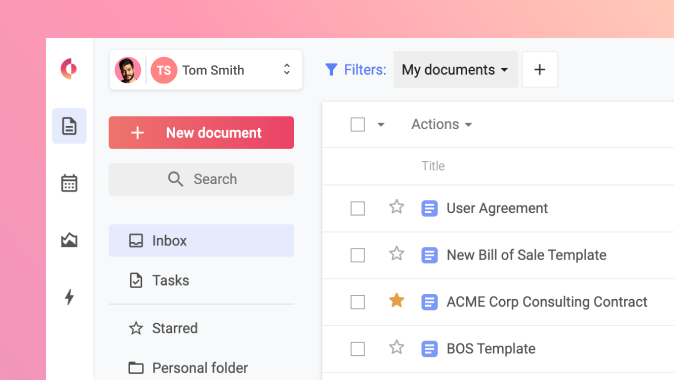5 Essential Elements of a Sales Contract
This is the second in a series of four posts on how to accelerate deals and win more revenue with contracts.
Read Part One in our series.
Five essential elements of a sales contract
When creating a sales contract (sales agreement, purchase agreement, etc.), regardless of the goods or service being sold, there are five key elements that are essential to moving deals along quickly and avoiding problems with the transaction down the road. Each of these elements sets expectations, and delivering on those expectations goes a long way toward creating repeat sales and long, mutually-beneficial business relationships.
1. The Description of Goods
There is nothing that will kill a deal faster than getting the yes for one thing and then having the wrong quantities or items in the contract. Having a lot of room for error, the description of goods is often considered the most important term. Include all the relevant details for the exact goods the buyer wants to purchase: type, model number, weight, color, size, number of seats, term length, plan, etc.
2. Delivery Instructions
Be clear about the time and date of delivery, the delivery location, and which party is responsible for the risk of loss of goods while they’re in transit. In the case of SaaS this would cover the implementation and onboarding period.
3. Inspection Period
The inspection period gives the buyer time to inspect the goods after delivery and reject any nonconforming goods. Depending on the goods involved the inspection period can vary greatly, but including this in sales contracts can go a long way toward building loyalty that results in renewals and repeat purchases. Other examples of this include POCs or trials.
4. Warranties and Guarantees
Any promises made during the selling process should be included in the sales contract. Variance from industry-to-industry and company-to-company in goods and services sold, means there is no “standard warranty” understanding that can be assumed, on either end. Be clear about the warranties included, if any, to properly set expectations for the future.
5. Payment Details
Including the price is a no-brainer. But what about the other terms and conditions of payment? Are there installments or is payment expected in a single lump sum? Were there accommodations made regarding a payment date, quarterly versus annual billing, or other agreements to close the sale? Are there special considerations for a given market?
Forgetting to include all the necessary payment details is like getting to the beach and forgetting the suits. Sure, you can swim naked but you risk a nasty burn. Better to be thorough and avoid the risk.
Special considerations for SaaS contracts
SaaS (Software-as-a-Service) contracts differ from traditional contracts in two ways: accessibility and price.
- SaaS, a cloud-based subscription service, often requires monthly subscription fees, yet sometimes paid annually. Pricing can also sometimes include any additional training or implementation costs. Point is, it’s more complicated than a one-and-done traditional software purchase, so be clear on what a buyer can expect to pay.
- Unlike traditional software and other goods, SaaS accessibility is not something physically owned, but accessed through an Internet connection for as long as the contract term states, conceivably forever.
These differences mean pricing plans, user’s access rights, SLAs, data rights and security, duration of agreement, and maintenance must be covered— absolutely in the contract but also in the sales process. Here are some key considerations for each.
1. Pricing
Clearly state what plan is being offered, what it includes, and how it will be billed. Is it billed per user, monthly? Are there additional costs for API? Explaining pricing can only work in a rep’s favor. A buyer that understands what they’re buying is less likely to stall or be surprised when the proposal is sent.
2. User’s Rights to Access
What constitutes a user? How many users does a plan allow? Is it unlimited? If proposing a certain number of users it behooves you to explain what a user is to help a buyer understand the benefit of purchasing at the suggested number. Who knows, maybe during discovery and conversation surrounding what a user is, it’ll come to light they need more than originally planned.
3. Service Level Agreement (SLA)
Anyone who’s sold SaaS is likely familiar with an SLA, but a buyer might not be. An SLA is a minimum performance standard—the percentage of time the service is guaranteed to work that a SaaS provider agrees or promises to meet. Including a standard clause related to SLA is highly recommended, which can also spell out how the performance standard is calculated.
4. Data
A consistent question when creating SaaS contracts is, “Who owns my data?” They do, so clearly state it in the contract.
5. Security
Security is a state of mind. Buyers need to feel like an organization is doing all it can, especially for SaaS (security checks, server compliance, data breach protection, data storage architecture, hosting, passwords), to want to sign a contract and trust it with their most prized possession—data.
As not a day seems to pass without news of some major hacking incident, data breach, or cyber mischief, it’s sales’ job to make sure to train and educate buyers and customers to how the Cloud works, and make sure they understand their business and information is safe.
6. Duration of Agreement
How long is this contract term for, 1 year, 3 years… longer? When is renewal required? Is there early termination? And what might that look like?
7. Maintenance of the Software
A main benefit of the Cloud is the automatic updates provided by the software service provider. Highlight these in sales conversations and clearly state in the contract which party is responsible for implementing and maintaining the service, including fixing bugs and pushing updates.
Each of these points ensure trust, confidence, and satisfaction, and each of those help accelerate the time-to-signature. However, getting the right information in the agreement to start with is just part of the battle. For sales, the biggest opportunity lies in next week’s post on how to accelerate deals and revenue.
Let’s talk about your sales contracts!
Concord’s mission is to help companies achieve scalability and efficiency by automating their most central process, contracts. The cloud-based solution enables over 300,000 users around the globe to create, collaborate, sign, store, and manage their agreements all in one place. Founded in 2014 and headquartered in San Francisco, Concord is built by business for business.



